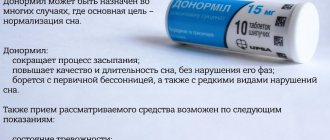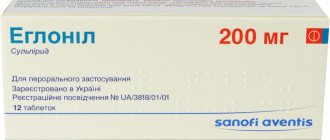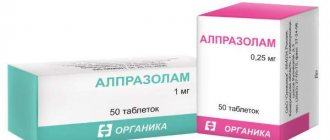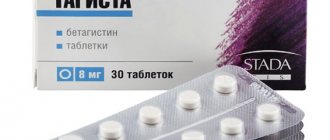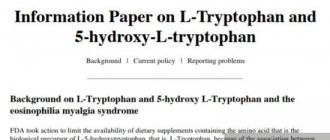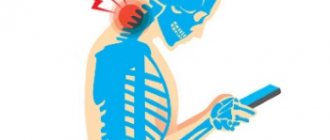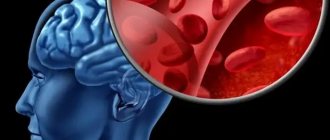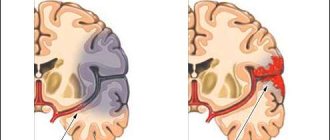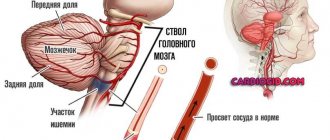Composition and release forms
Capsules for oral administration;
Solution in ampoules for intravenous or intramuscular administration.
Capsules are often called tablets in everyday life, meaning a dosage form intended for oral administration. Of course, capsules are not the same dosage form as tablets, but at the everyday level, both names may well be used to designate a type of drug for oral administration. You just need to remember that if a person says “Gliatilin tablets,” he means the oral form, that is, capsules.
Gliatilin capsules are available in packs of 14 pieces. The solution for intravenous and intramuscular injection is available in 4 ml ampoules, which are packaged in cardboard boxes of 1 or 3 pieces. Gliatilin solution is a clear, colorless liquid without any odor. The capsules have an oval-shaped gelatin shell, colored yellow. Inside the capsules there is a viscous, colorless solution.
Gliatilin capsules and solution for injection contain choline alfoscerate as the active substance. The capsules have a dosage of the active substance of 400 mg, and the solution is 250 mg/ml. That is, each capsule contains 400 mg of choline alfoscerate, and 1 ml of injection solution contains 250 mg. Accordingly, a full ampoule with 4 ml of solution contains 1000 mg of the active substance.
As an excipient, the injection solution contains only distilled deionized sterile water. Gliatilin capsules contain the following substances as auxiliary components:
- Glycerol;
- Titanium dioxide;
- Gelatin;
- Iron(III) metahydroxide;
- Purified water;
- Sodium propyl parahydroxybenzoate;
- Sorbitans;
- Sodium ethyl parahydroxybenzoate;
- Esitol.
Comparison of side effects of Gliatilin and Nootropil
Side effects or adverse events are any adverse medical event that occurs in a subject after administration of a drug.
Gliatilin's side effects are almost the same as Nootropil's. They both have few side effects. This implies that the frequency of their occurrence is low, that is, the indicator of how many cases of an undesirable effect of treatment are possible and registered is low. The undesirable effect on the body, the strength of influence and the toxic effect of Gliatilin are similar to Nootropil: how quickly the body recovers after taking it and whether it recovers at all.
Therapeutic effect
Gliatilin is a centrally acting cholinomimetic, that is, it has an activating effect on cholinergic receptors in brain structures. According to its pharmacological action, the drug is a nootropic and neuroprotector.
Once in the brain, Gliatilin breaks down to release choline and glycerophosphate. Choline is involved in the formation of acetylcholine, a substance that is the main mediator of nervous excitation. It is thanks to acetylcholine that a signal is transmitted from one brain cell to another. In fact, the presence of a sufficient amount of acetylcholine determines the high rate of information exchange between brain structures.
And glycerophosphate is involved in the formation of phospholipids - substances that make up the cell membrane. Accordingly, with a sufficient amount of phospholipids, cells have a strong membrane that reliably protects them from the negative effects of environmental factors.
Thus, on the one hand, Gliatilin accelerates and improves the transmission of nerve impulses between brain cells, and on the other hand, it makes neurons stronger and more resistant to the adverse effects of environmental factors (for example, hypoxia, etc.).
In addition, Gliatilin improves cerebral circulation, accelerates the metabolic process in brain cells and restores consciousness after traumatic damage to various brain structures. When used in the acute period of traumatic brain injury, Gliatilin improves blood flow and bioelectrical activity in the affected area, and also promotes a more rapid disappearance of neurological symptoms and the restoration of normal consciousness. Gliatilin also promotes rapid restoration and normalization of structures damaged during ischemic stroke in areas of the brain.
Gliatilin also improves cognitive abilities (memory, attention and thinking) in people suffering from mild or severe degrees of dementia caused by cerebral circulatory disorders of various origins, for example, cerebral atherosclerosis, dyscirculatory encephalopathy, arterial hypertension, Alzheimer's disease, etc.
In all people (both healthy and those suffering from mental impairment), Gliatilin improves mood and emotional stability, activates thinking, and relieves irritability and apathy.
Comparison of the effectiveness of Gliatilin and Nootropil
The effectiveness of Gliatilin is quite similar to Nootropil - this means that the ability of the drug substance to provide the maximum possible effect is similar.
For example, if the therapeutic effect of Gliatilin is more pronounced, then using Nootropil even in large doses will not achieve this effect.
Also, the speed of therapy - an indicator of the speed of therapeutic action - is approximately the same for Gliatilin and Nootropil. And bioavailability, that is, the amount of a drug reaching its site of action in the body, is similar. The higher the bioavailability, the less it will be lost during absorption and use by the body.
Indications for use
Gliatilin is indicated for use in the following conditions and diseases:
- Acute period of traumatic brain injury, in which the brain stem is predominantly affected and there are corresponding symptoms (impaired consciousness, coma, etc.);
- Acute and recovery period of ischemic stroke;
- Recovery period of hemorrhagic stroke;
- Degenerative and involutional psychoorganic syndromes, manifested by memory impairment, confusion, disorientation, decreased motivation, initiative and concentration;
- Chronic cerebral circulatory failure (dyscirculatory encephalopathy);
- Violations of emotional stability and behavior, such as emotional lability, irritability, low interest in life, senile pseudomelancholy;
- Dementia caused by various causes (Alzheimer's, senile, mixed forms);
- Alzheimer's disease;
- Huntington's chorea;
- Disorders of cognitive function (impaired thinking, memory and concentration in older people, as well as confusion, disorientation, decreased motivation and initiative).
Gliatilin capsules and injections are contraindicated for use if a person has the following conditions or diseases:
- Individual hypersensitivity or allergic reactions to the components of the drug;
- The period of pregnancy and breastfeeding.
Gliatilin - instructions for use
General provisions
Gliatilin capsules are taken orally and used to treat chronic conditions over a long period of time. Gliatilin solution is administered intravenously or intramuscularly and is used in the treatment of acute conditions for a relatively short period of time. In addition, for severe diseases, the use of Gliatilin in the form of injections and capsules is combined, that is, the solution is first administered intravenously or intramuscularly, and then treatment is continued by taking capsules orally.
The choice of method of use of Gliatilin is made by the doctor depending on the severity of the disease and the patient’s condition. Let's consider the schemes, rules of use and dosage of Gliatilin solution and capsules for the treatment of various conditions and diseases.
The capsules should be swallowed whole, without biting or opening in any other way, and washed down with a small amount of non-carbonated drink.
. It is better to take capsules before meals.
If you need to take capsules several times a day, then you should divide the daily dosage into unequal parts so that you take most of the dose in the morning and less in the afternoon. This is necessary to neutralize the possible stimulating effect of the drug, which may cause difficulty falling asleep if taken in the evening.
For chronic diseases, treatment immediately begins with taking 400 mg capsules (1 capsule) 2–3 times a day, and continues for 3–6 months. In acute conditions, first a course of Gliatilin injections is administered (one ampoule is administered - 1000 mg per day), after which they immediately, without interruptions, switch to taking the drug in capsule form (2 capsules in the morning and one in the afternoon), which is continued for six months.
Let's consider the dosages and duration of therapy for various chronic conditions with Gliatilin capsules:
- The rehabilitation period after a stroke - take 400 mg orally (1 capsule) 2 times a day for two months.
- Early recovery period after a stroke - take 400 mg orally (1 capsule) 2 times a day for 2 months, starting from the second week after the stroke.
- Profound disturbances in movement, thinking, speech and mental activity after a stroke - take 400 mg orally (1 capsule) 2 times a day for six months. You can start taking capsules from the second week after a stroke.
- Dementia (dementia), Alzheimer's disease and dyscirculatory encephalopathy (cerebral circulatory disorders) with severe impairment of motor and intellectual function - first Gliatilin is injected for 5 - 14 days (one ampoule 2 times a day), and then taken for six months orally 400 mg (1 capsule) 2 times a day.
- Cerebral circulation disorders (dyscirculatory encephalopathy, chronic cerebral circulatory failure, etc.) – take 400 mg orally (1 capsule) 2 times a day, for 1 – 2 months.
- Brain contusion or polytrauma (damage to various parts of the body) - within a week after the injury, Gliatilin is administered by injection (1 ampoule once a day), then from the second week 400 mg (1 capsule) is taken orally, 2 times a day, for 2 months.
- Concussion - take 400 mg (1 capsule) orally from the first day of injury, 2 times a day, for a month.
- Traumatic brain injury in children - within a week after the injury, Gliatilin is administered by injection (1 ampoule once a day), then from the second week 400 mg (1 capsule) is taken orally, 2 times a day, for 2 months.
If, while taking Gliatilin capsules, a person experiences
, then you should reduce the dosage of the drug and continue treatment.
These dosage regimens are standard, but if necessary, the duration of therapy can be increased or decreased. Also, if necessary, you can take repeated courses of Gliatilin capsules, maintaining intervals between them of at least 4 - 6 months. Remember, the longer the course of therapy, the longer the break should be until the next one.
Gliatilin injections
The solution can be administered intravenously or intramuscularly. Intravenous Gliatilin is administered as an infusion (“dropper”), after diluting the contents of the ampoule (4 ml of solution) in 50 ml of physiological solution. Then the prepared infusion solution is administered at a rate of 60 - 80 drops per minute.
To perform an intramuscular injection, the Gliatilin solution from the ampoule is drawn into a sterile syringe of the required volume. For example, if you need to administer 1000 mg of the drug, then take a 4-5 ml syringe to remove the entire solution from the ampoule. If you need to administer only 500 mg of the drug, then take a 2 ml syringe to select from the ampoule only 2 ml of solution, which contains 500 mg of Gliatilin.
Intramuscular injections are recommended to be made into the anterolateral surface of the thigh, the upper outer part of the shoulder, and for slender people also into the anterior wall of the abdomen. It is not recommended to give an intramuscular injection into the buttocks, since in this area of the body the muscles lie very deep and there is a high risk of injecting the solution into the subcutaneous fat layer, from where the medicine will not be absorbed into the blood at a sufficient speed.
Before performing the injection, it is necessary to treat the injection site with a cotton swab moistened with an antiseptic (alcohol, Belasept, Chlorhexidine, etc.). After this, the needle is inserted deep into the tissue, holding it perpendicular to the surface of the skin. When 2–4 mm remains from the skin to the needle holder, stop inserting the needle into the tissue and begin to slowly press on the syringe plunger, releasing the medicine into the muscle. Having injected the entire solution into the tissue, the needle is removed, and the injection site is wiped again with a cotton swab moistened with an antiseptic.
The ampoule with Gliatilin solution should be opened immediately before use. Do not store the solution in an opened container. That is, if the ampoule has been opened, you must either use the solution or throw it away. If not the entire ampoule is used for injection, then the required amount of solution is drawn into the syringe, and the remainder is thrown away.
The dosage of Gliatilin for intravenous and intramuscular injections for various diseases is the same and is 1000 mg (one full ampoule of solution - 4 ml) at a time. Intramuscular injections are given a maximum of once a day, and intravenous injections - 1 to 3 times. The duration of use of intravenous and intramuscular injections for various diseases is also the same and ranges from 7 to 10 days.
Injections are best done in the first half of the day, preferably before meals. The method of administering the medicine is determined by the doctor and depends on the patient’s condition. If a person is in critical condition, unconscious or cannot walk independently, then Gliatilin is administered intravenously. If a person is able to walk and responds adequately to the surrounding reality, then Gliatilin can be administered intramuscularly.
Let's consider the dosages and duration of use of Gliatilin injections for various conditions and diseases:
- The most acute period of ischemic stroke - administer 1000 mg (1 ampoule) intravenously or intramuscularly 2 times a day for 3 to 5 days. From the second week after the stroke, you can start taking 400 mg capsules (1 capsule) 2 times a day for a month.
- The most acute period of hemorrhagic stroke - administer 1000 mg (1 ampoule) intravenously or intramuscularly 2 times a day for 5 to 14 days. From the second week after the stroke, you can start taking 400 mg capsules (1 capsule) 2 times a day for a month.
- Stroke with a disorder of consciousness requiring the maintenance of vital functions - administer intravenously 1000 mg (1 ampoule) 4 times a day, at regular intervals of 6 hours, for 5 - 7 days.
- Dementia (dementia), Alzheimer's disease and dyscirculatory encephalopathy (cerebral circulatory disorders) with severe impairment of motor and intellectual function - for 5 to 14 days, administer Gliatilin intravenously or intramuscularly, one ampoule (1000 mg) 2 times a day, and then for six months, take 400 mg (1 capsule) orally 2 times a day.
- Brain contusion with a disorder of consciousness requiring the maintenance of vital functions - administer intravenously 1000 mg (1 ampoule) 4 times a day, at regular intervals of 6 hours, for 5 - 7 days.
- Brain contusion of moderate or mild severity, or polytrauma (injury to several parts of the body) - administer 1000 mg (1 ampoule) intravenously or intramuscularly once a day for 7 days, starting from the first day of injury. Starting from the second week after injury, continue treatment with 400 mg capsules (1 capsule) 2 times a day for two months.
- Traumatic brain injury in children - administer intravenously or intramuscularly 1000 mg (1 ampoule) once a day for 7 days, starting from the first day of injury. Starting from the second week after injury, continue treatment with 400 mg capsules (1 capsule) 2 times a day for two months.
- Heart disease or surgical interventions that may be complicated by the development of ischemic brain damage - administer 1000 mg (1 ampoule) intravenously or intramuscularly once a day for 3 to 7 days. The signal for the administration of Gliatilin in such cases is the development of the phenomenon of cardiac embolism or systemic arterial hypotension. Gliatilin can be administered in the early postoperative period or before surgery to prevent complications in the form of ischemic brain damage (if there is a risk of developing such complications).
After completing the course of Gliatilin injections, to obtain a more lasting or pronounced therapeutic effect, you can always continue treatment by taking capsules. Capsules for various conditions and diseases are taken in the same dosage - 400 mg (1 capsule) 2 times a day for 1 - 6 months.
If the condition is severe, then you are allowed to take 800 mg (2 capsules) in the morning and 400 mg (1 capsule) in the afternoon for a month. If it is necessary to continue treatment after a month of taking Gliatilin at a daily dosage of 1200 mg (2 capsules in the morning and 1 in the afternoon), you should reduce the dose and take 400 mg (1 capsule) 2 times a day for another 1 to 5 months.
Gliatilin for children
General provisions
Gliatilin, like other nootropics, is often prescribed to young children to eliminate motor, mental or speech delays.
, or to eliminate the consequences of birth trauma and perinatal encephalopathy. In more rare cases, the drug is used to treat traumatic brain injury, concussion, or brain contusion. Children under 7 years of age are usually prescribed Gliatilin in the form of injections, since when using the solution, the required dosage of the drug can be measured, which is smaller than for adults.
With various options
In children of any age, Gliatilin is best used in the form of intramuscular injections for a number of reasons. Firstly, when using the solution, you can measure the dosage the child needs. Secondly, the course of therapy with Gliatilin injections is much shorter than when taking tablets (for example, injections are given for 5 - 14 days, and capsules are taken for 1 - 3 months). Finally, thirdly, Gliatilin injections are often much more effective than taking capsules.
In case of developmental delay, consequences of birth trauma or perinatal encephalopathy, children of the first year of life are administered intramuscularly with 1 - 2 ml of solution (250 - 500 mg) of Gliatilin once a day, for 10 - 12 days. For children aged 1 - 3 years, the solution is administered 2 - 3 ml once a day, for 10 - 12 days.
In case of developmental delay, consequences of birth trauma and perinatal encephalopathy, the drug can be used for children and in capsules. If a child over one year old can easily swallow a whole capsule of Gliatilin, then he should be given the drug 400 mg (1 capsule) 2 times a day for 1 to 3 months.
If a child older than one year cannot swallow the capsule, then you should carefully pierce its shell with a needle and draw its contents into a syringe. Then all the liquid contents drawn out from the capsule with a syringe should be poured into the child’s mouth (after first separating the needle from the syringe) and give him still water to drink.
For the same conditions, children under one year of age are strongly recommended to use Gliatilin injections rather than capsules. However, if for some reason you have to give a child under one year of age the drug in capsule form, then it is recommended to do so as follows. First, pierce the capsule with a needle attached to a syringe and draw out all its contents.
Then, having disconnected the needle, carefully pull back the child’s lower lip and drop 4–6 drops of the solution drawn from the capsule from a syringe into the space between the lip and gums. After this, you need to give the child something to drink. Thus, the child is given the drug 4 - 6 drops 2 times a day, for 1 - 3 months.
In case of traumatic brain injury, concussion or contusion, it is recommended to administer Gliatilin intravenously or intramuscularly at 1000 mg (1 ampoule) once a day for 7 days, starting from the first day of injury. Starting from the second week after injury, you can continue treatment by taking 400 mg capsules (1 capsule) 2 times a day for two months.
Comparison of addiction between Gliatilin and Nootropil
Like safety, addiction also involves many factors that must be considered when evaluating a drug.
So, the totality of the values of such parameters as “o syndrome” in Gliatilin is quite similar to the similar values in Nootropil. Withdrawal syndrome is a pathological condition that occurs after the cessation of intake of addictive or dependent substances into the body. And resistance is understood as initial immunity to a drug; in this it differs from addiction, when immunity to a drug develops over a certain period of time. The presence of resistance can only be stated if an attempt has been made to increase the dose of the drug to the maximum possible. At the same time, Gliatilin has quite a small value of “syndrome”, however, the same as Nootropil.
Analogs
On the pharmaceutical market, almost every drug has analogues, which are divided into two types - synonyms and, in fact, analogues. Synonyms are drugs that, like Gliatilin, contain choline alfoscerate as an active substance. Analogues are drugs that contain other active substances, but have a spectrum of therapeutic action that is maximally similar to Gliatilin.
So, the following drugs are synonymous with Gliatilin:
- Gleatser solution for injection;
- Delecite capsules, oral solution and injection solution;
- Noocholin Rompharm solution for injection;
- Choline alfoscerate solution for injection;
- Holitylin capsules and solution for injection;
- Cerepro capsules and solution for injection;
- Cereton capsules and solution for injection.
- Amylonosar tablets and solution for injection;
- Acefen tablets;
- Bravinton concentrate for the preparation of solution for infusion;
- Vinpotropil capsules, tablets and concentrate for the preparation of solution for infusion;
- Vinpocetine tablets and concentrate for the preparation of solution for infusion;
- Vinpocetine Forte tablets;
- Vincetin tablets;
- Ginkgo Biloba tablets and capsules;
- Ginkoum capsules;
- Glycine tablets sublingual and buccal;
- Gopantam tablets;
- Demanol solution for oral administration;
- Idebenone capsules and tablets;
- Cavinton tablets and concentrate for the preparation of solution for infusion;
- Cavinton Forte and Cavinton Comforte tablets;
- Calcium hopantenate tablets;
- Carnitex capsules;
- Carnicetine capsules;
- Cogitum solution for oral administration;
- Combitropil capsules;
- Korsavin and Korsavin Forte tablets;
- Cortexin lyophilisate for the preparation of solution for injection;
- Lucetam tablets and solution for injection;
- Memotropil tablets;
- Minisem nasal drops;
- Neypilept solution for injection;
- Neuromet capsules;
- Noben capsules;
- NooCam capsules;
- Nooclerin solution for oral administration;
- Noopept tablets;
- Nootropil capsules, tablets and solution for injection;
- Omaron tablets;
- Pantogam syrup and tablets;
- Pantogam active capsules;
- Pantocalcin tablets;
- Picamilon tablets and solution for injection;
- Picanoyl tablets;
- Pikogam tablets;
- Pineamin lyophilisate for the preparation of solution for injection;
- Pyracesin capsules;
- Piracetam capsules, tablets, granules for the preparation of syrup for children, solution for injection;
- Pyriditol tablets;
- Semax nasal drops;
- Telektol tablets;
- Thiocetam tablets and solution for injection;
- Fezam capsules;
- Phenotropil tablets;
- Celestab capsules;
- Cellex solution for subcutaneous administration;
- Ceraxon solution for oral administration and injection;
- Cerebrolysate solution for injection;
- Cerebrolysin solution for injection;
- Encephabol tablets and oral suspension;
- Epithalamin powder for solution for injection;
- Escotropil solution for infusion.
- Gleatser solution for injection;
- Noocholin Rompharm solution for injection;
- Cerepro capsules and solution for injection;
- Cereton capsules and solution for injection.
- Vinpotropil capsules, tablets and concentrate for the preparation of solution for infusion;
- Vinpocetine tablets and concentrate for the preparation of solution for infusion;
- Ginkgo Biloba tablets and capsules;
- Glycine tablets sublingual and buccal;
- Gopantam tablets;
- Cavinton tablets and concentrate for the preparation of solution for infusion;
- Calcium hopantenate tablets;
- Korsavin and Korsavin Forte tablets;
- Lucetam tablets and solution for injection;
- Memotropil tablets;
- Noben capsules;
- Nooclerin solution for oral administration;
- Noopept tablets;
- Nootropil capsules, tablets and solution for injection;
- Omaron tablets;
- Picamilon tablets and solution for injection;
- Pikogam tablets;
- Piracetam capsules, tablets, granules for the preparation of syrup for children, solution for injection;
- Telektol tablets;
- Thiocetam tablets and solution for injection;
- Phezam capsules.
